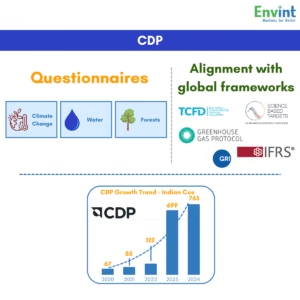CDP has become a global benchmark for climate disclosure, enabling companies to share concrete, comparable data on emissions, risks, and transition plans. Reporting to CDP signals a company’s readiness to operate in a climate-conscious economy.
What is CDP?
CDP is one of the world’s leading climate disclosure platforms for companies and investors to measure, manage, and report their climate impacts. CDP primarily addresses climate-related risks, with its framework focusing broadly on environmental issues. It aligns with major frameworks such as TCFD, ISSB, SBTi, and GRI, helping organizations disclose comprehensive, comparable, and decision-useful data for effective sustainability action.
What does CDP reporting cover?
CDP’s corporate questionnaire is designed around three core environmental themes:
1. Climate Change – covering emissions data, reduction targets, transition strategies, and climate-related risks and opportunities.
2. Water Security – addressing risks, withdrawals, discharges, and water management practices.
3. Forests – focusing on deforestation risks linked to key commodities and related mitigation actions.
In recent years, CDP has also expanded its scope to include Biodiversity and Plastics. These newer areas are currently treated as supplementary topics in the integrated questionnaire. While they are not yet scored, they reflect the growing importance of ecosystems, species, and circular economy issues in sustainability reporting.
Integrated Questionnaire Modules for Companies
Starting in 2024, CDP shifted from separate questionnaires to a single Integrated Questionnaire for companies. Instead of filling out different forms for climate, water, or forests, companies now respond through one streamlined questionnaire that brings all themes together.
This integrated format is built around modules, which are sets of questions relevant to specific environmental themes.
1. Core Modules – Climate Change, Water Security, and Forests (the primary, scored areas).
2. Supplementary Modules – Biodiversity and Plastics (newer focus areas, included but not yet scored).
3. Cross-cutting Modules – Governance, risk management, targets, and opportunities that apply across multiple themes.
The modular design allows CDP to expand coverage without overburdening companies. Each organization only responds to the modules relevant to its operations and supply chains.
CDP-ACS and Sector-Specific Questionnaires
CDP has sector-specific questionnaires or modules, and they include tailored versions for SMEs and financial services firms. CDP developed the Activity Classification System (CDP-ACS) to allocate sector-specific questions to companies efficiently which categorizes companies based on core revenue-generating activities. CDP follows a sector-based scoring approach where companies are assigned a primary questionnaire sector based on CDP-ACS.
Disclosure cycle
CDP runs an annual disclosure cycle where companies respond to detailed questionnaires on climate, water, and forests. Organizations that submit within the main window are eligible to receive a score, while late submissions may still be accepted but are typically not scored.

How can we help you?
At Envint, we simplify your CDP reporting and help improve your performance by developing:
- CDP Gap Assessment for improved scoring.
- Conducting a comprehensive review of your current sustainability practices.
- Engaging with suppliers to strengthen your disclosure.
- Setting and monitoring measurable targets aligned with global sustainability goals.
- Delivering meaningful results that enhance your reputation and enhance your CDP scores year after year.
Conclusion
Reach out to us at connect@envintglobal.com today to make your CDP reporting seamless and impactful.
While CDP focuses specifically on climate-related disclosures, companies often navigate a broader reporting landscape that includes ESG frameworks and national regulations. Read more about ESG reporting in India.

